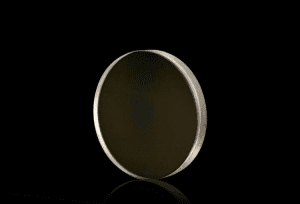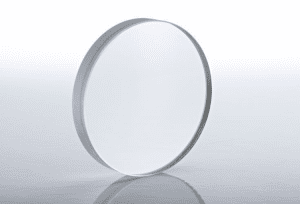MgF2 Windows
MgF2 Windows: Uses and Optical Characteristics
An MgF2 window is an optical window crafted from crystalline Magnesium Fluoride. This robust and enduring optical material is well-suited for applications in demanding environments. It boasts exceptional resistance to chemical corrosion, as well as resistance to mechanical and thermal shocks. Additionally, it possesses a high threshold for laser damage.
MgF2 exhibits remarkable broadband transmission spanning from 120 nm to 8 μm, covering the deep ultraviolet to the mid-infrared spectrum. This property makes it an excellent choice for UV radiation sources and detectors, including applications involving the Hydrogen Lyman-alpha line. Frequently, it finds use as a UV viewing window, serving as an ideal candidate for UV polarizers and excimer laser applications. It maintains high transmittance between 120 nm and 8 µm, with a transmission rate exceeding 90% between 0.4-5.0 µm.
MgF2 has a melting point of 1255 degrees Celsius, a density of 3.177 g/cm3, and a tetragonal crystal structure. Typically, our optical windows are oriented with their circular surfaces perpendicular to the c-axis of the MgF2 crystal to minimize birefringence. Upon request, we can manufacture custom MgF2 windows with random cuts.
MgF2 stands alone among optical materials in its ability to combine a broad spectral transmission range with birefringence. Birefringence means that the refractive index depends on the polarization and direction of light propagation. Due to this property, a MgF2 window can exhibit double refraction, causing a beam of light to split into two rays following different paths.
The ray with a higher effective refractive index within the optical window is referred to as the “slow ray,” while the one with the lower effective refractive index is termed the “fast ray.” When a beam enters the MgF2 window from air, the slow ray will be refracted more toward the normal direction.
It’s important to handle MgF2 with care, as it is softer than fused silica, although it ranks as the hardest of the optical fluorides with a hardness rating of HK576.


MgF2 Windows at Avantier
Our Magnesium Fluoride Windows are available in a wide range of sizes, ranging from 3.5 to 25.4 mm in diameter and 1.0 to 3.0 mm in thickness. Our factory standards stipulate a diameter tolerance of +0.0, – 0.05mm and a thickness tolerance of +/- 0.1mm, meeting the precision quality standards in the industry.
The clear aperture of our windows exceeds 90 percent, with wavefront distortion not exceeding l/4 per 25 mm.
Parallelism refers to the alignment of the two planar surfaces of our windows. Our factory standard dictates a maximum deviation of 5 arc minutes.
The scratch and dig number, as per our factory standards for Magnesium Fluoride Windows, is 40-20, signifying precision quality. These numbers indicate how the size of scratches and digs compares to the reference in MIL-PRF-13830B specifications. A rating of 40 implies that any scratches on the window’s surface are no brighter than those designated as 40 in the specification. The total length of all scratches designated as 40 degrees may not exceed ¼ of the window’s diameter. The dig number, 20, means that the maximum allowable size of digs or pits on the optic’s surface is 0.2 mm, with their total count not exceeding the diameter divided by twenty.
Material |
MgF2 |
Irregularity (fringe) |
l/4 |
Diameter Tolerance |
+0.0, -0.05mm |
Thickness Tolerance |
+/- 0.1mm |
Clear Aperture (%) |
>90% |
Parallelism |
5 arc min |
Surface Quality |
40-20 |
Wavefront Distortion |
l/4 per 25mm |
Feel free to contact us for inquiries about manufacturing limits or custom specifications. Our dedicated design team is eager to collaborate with you in identifying the optimal optical solution tailored to your specific application.
WE CAN HELP YOU!
Contact us NOW for sales & expert advice.

